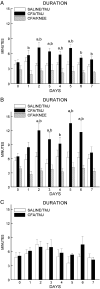Measuring persistent temporomandibular joint nociception in rats and two mice strains
- PMID: 20152846
- PMCID: PMC2854343
- DOI: 10.1016/j.physbeh.2010.01.037
Measuring persistent temporomandibular joint nociception in rats and two mice strains
Abstract
Temporomandibular joint (TMJ) pain has been reported to last for prolonged periods in humans. In rodents a variety of methods have been used to measure TMJ nociception, but for most of these methods the period of measurement has been minutes to a couple of hours. In addition, most measurement protocols required restraint or training of the animal. Previous studies from our laboratory demonstrated that feeding behavior, particularly meal duration, was an indicator of TMJ nociception in unrestrained and untrained male and female Sprague-Dawley rats for up to two days. In this study, we first found that injection of complete Freund's adjuvant (CFA) into the TMJ of rats significantly lengthened meal duration for 19 days and also decreased meal frequency for 42 days. Interestingly, the meal duration varied significantly from day to day within the 19 day period. TMJ interleukin-1 beta (IL-1 beta) and calcitonin gene-related peptide (CGRP) were significantly elevated in the TMJ tissues of CFA-injected animals and the level of these markers was attenuated as the meal duration decreased with time. Control animals injected with saline into the TMJ or CFA into the knee did not show a significant lengthening in meal duration but did show a decrease in meal frequency. In a second study, DBA/1LacJ mice given TMJ CFA injections showed a significantly lengthened meal duration on four of the seven days measured using end-of-the meal definition of 5 or 10 min. No other meal pattern changed significantly. Two days post-CFA injection, the DBA/1LacJ mice showed significantly elevated interleukin-6 (IL-6), but not elevated IL-1 beta. Seven days post-injection, both IL-6 and IL-1 beta were significantly elevated. No change in CGRP was detected. In this study C57Bl/6 mice also received TMJ CFA injections, but they did not show a lengthening in any meal pattern or significant increases in IL-1 beta, IL-6 or CGRP. Our data show, for the first time, that meal duration can be used to measure CFA-induced nociception in the TMJ over the course of several weeks in unrestrained rats and for up to seven days in the DBA/1LacJ mouse strain. In addition, C57Bl/6 mice are resistant to CFA-induced TMJ nociception at the same dose used in the DBA/1LacJ mice.
(c) 2010 Elsevier Inc. All rights reserved.
Figures






Similar articles
-
Specificity of meal pattern analysis as an animal model of determining temporomandibular joint inflammation/pain.Int J Oral Maxillofac Surg. 2005 Jun;34(4):425-31. doi: 10.1016/j.ijom.2004.08.010. Int J Oral Maxillofac Surg. 2005. PMID: 16053854
-
Modulation of temporomandibular joint nociception and inflammation in male rats after administering a physiological concentration of 17β-oestradiol.Eur J Pain. 2013 Feb;17(2):174-84. doi: 10.1002/j.1532-2149.2012.00183.x. Epub 2012 Jun 19. Eur J Pain. 2013. PMID: 22715057 Free PMC article.
-
Capsaicin sensitive neurons role in the inflamed TMJ acute nociceptive response of female and male rats.Physiol Behav. 2007 Apr 23;90(5):782-9. doi: 10.1016/j.physbeh.2007.01.002. Epub 2007 Jan 18. Physiol Behav. 2007. PMID: 17316714
-
Regulation of the trigeminal NR1 subunit expression induced by inflammation of the temporomandibular joint region in rats.Pain. 2009 Jan;141(1-2):97-103. doi: 10.1016/j.pain.2008.10.021. Epub 2008 Dec 5. Pain. 2009. PMID: 19058915 Free PMC article.
-
Temporal changes in inflammatory mediator concentrations in an adjuvant model of temporomandibular joint inflammation.J Orofac Pain. 2005 Winter;19(1):34-40. J Orofac Pain. 2005. PMID: 15779537
Cited by
-
Sensory Neuron-TRPV4 Modulates Temporomandibular Disorder Pain Via CGRP in Mice.J Pain. 2023 May;24(5):782-795. doi: 10.1016/j.jpain.2022.12.001. Epub 2022 Dec 9. J Pain. 2023. PMID: 36509176 Free PMC article. Review.
-
Distance-based permutation of inter-meal differences as a sensitive test of temporomandibular joint nociception in rats.J Appl Biobehav Res. 2017 Sep;22(3):e12067. doi: 10.1111/jabr.12067. Epub 2017 Apr 18. J Appl Biobehav Res. 2017. PMID: 29104423 Free PMC article.
-
Cutting edge: Humanized nano-proresolving medicines mimic inflammation-resolution and enhance wound healing.J Immunol. 2011 May 15;186(10):5543-7. doi: 10.4049/jimmunol.1003865. Epub 2011 Apr 1. J Immunol. 2011. PMID: 21460209 Free PMC article.
-
Reduced GABA(A) receptor α6 expression in the trigeminal ganglion alters inflammatory TMJ hypersensitivity.Neuroscience. 2012 Jun 28;213:179-90. doi: 10.1016/j.neuroscience.2012.03.059. Epub 2012 Apr 19. Neuroscience. 2012. PMID: 22521829 Free PMC article.
-
Chronic inflammatory pain prevents tolerance to the antinociceptive effect of morphine microinjected into the ventrolateral periaqueductal gray of the rat.J Pain. 2013 Dec;14(12):1601-10. doi: 10.1016/j.jpain.2013.08.003. Epub 2013 Oct 22. J Pain. 2013. PMID: 24161274 Free PMC article.
References
-
- Chang H, Israel H. Analysis of inflammatory mediators in temporomandibular joint synovial fluid lavage samples of symptomatic patients and asymptomatic controls. J Oral Maxillofac Surg. 2005;63:761–765. - PubMed
-
- Kerins C, Carlson D, McIntosh J, Bellinger L. A role for cyclooxygenase II inhibitors in modulating temporomandibular joint inflammation from a meal pattern analysis perspective. J Oral Maxillofac Surg. 2004;62:989–995. - PubMed
-
- Thut PD, Hermanstyne TO, Flake NM, Gold MS. An operant conditioning model to assess changes in feeding behavior associated with temporomandibular joint inflammation in the rat. J Orofac Pain. 2007;21:7–18. - PubMed
-
- Kerins CA, Carlson DS, Hinton RJ, Grogan DM, Marr K, Kramer PR, Spears RD, Bellinger LL. Specificity of meal pattern analysis as an animal model of dermining temporomandibular joint inflammation/pain. International Journal of Oral Maxiollofacial Surgery. 2005;34:425–431. - PubMed
Publication types
MeSH terms
Substances
Grants and funding
LinkOut - more resources
Full Text Sources
Medical
Research Materials

